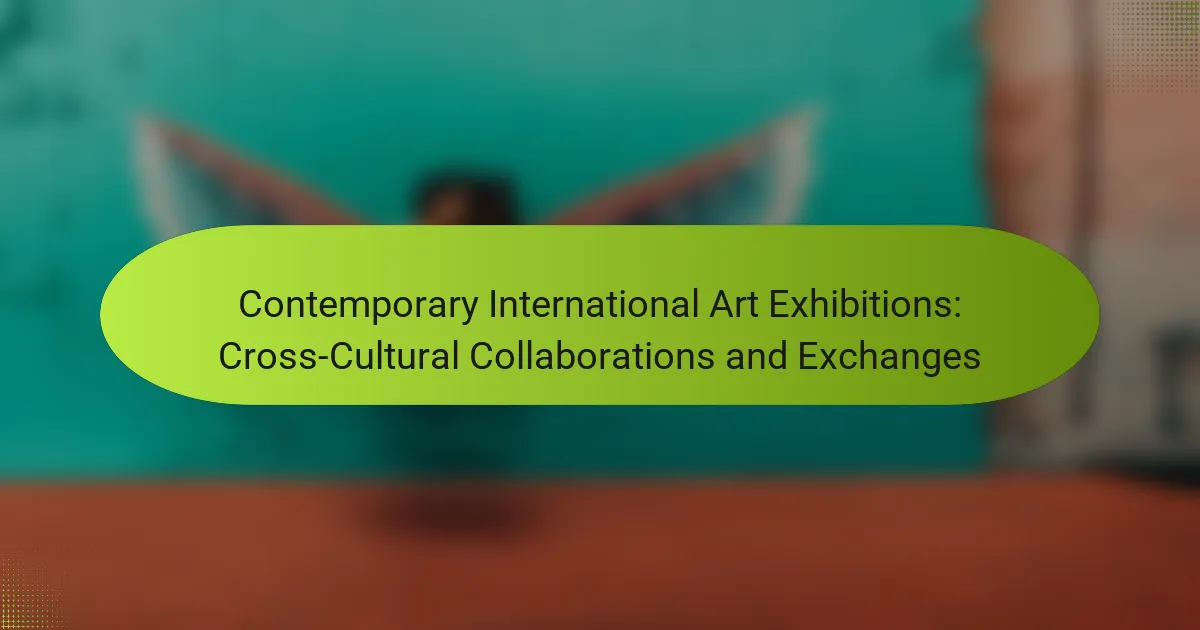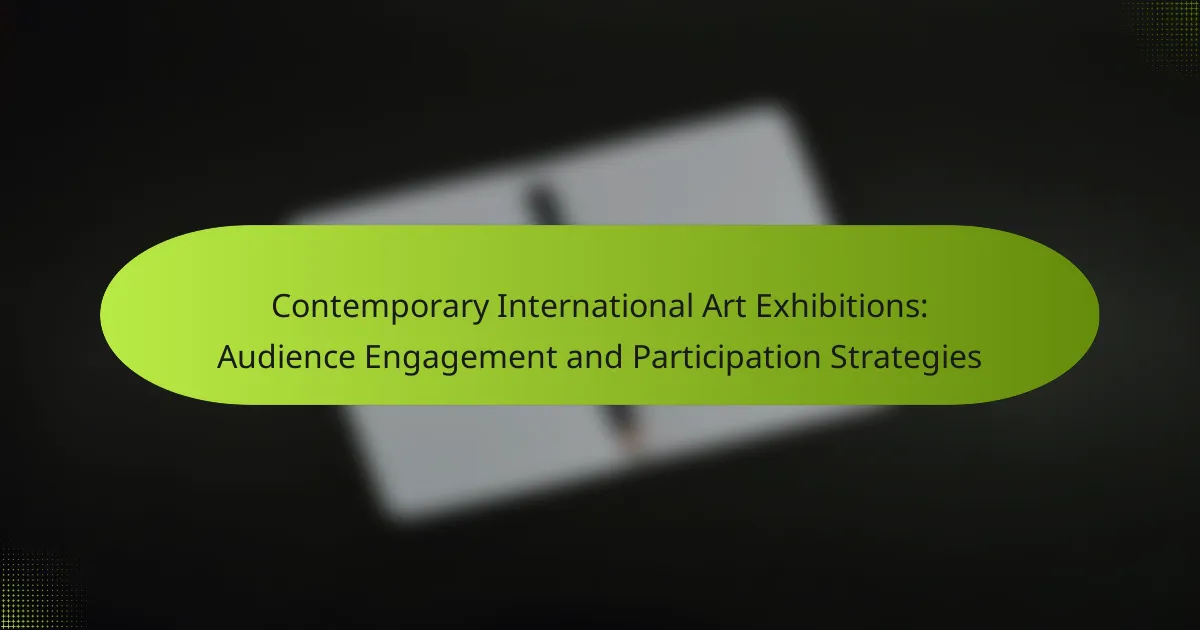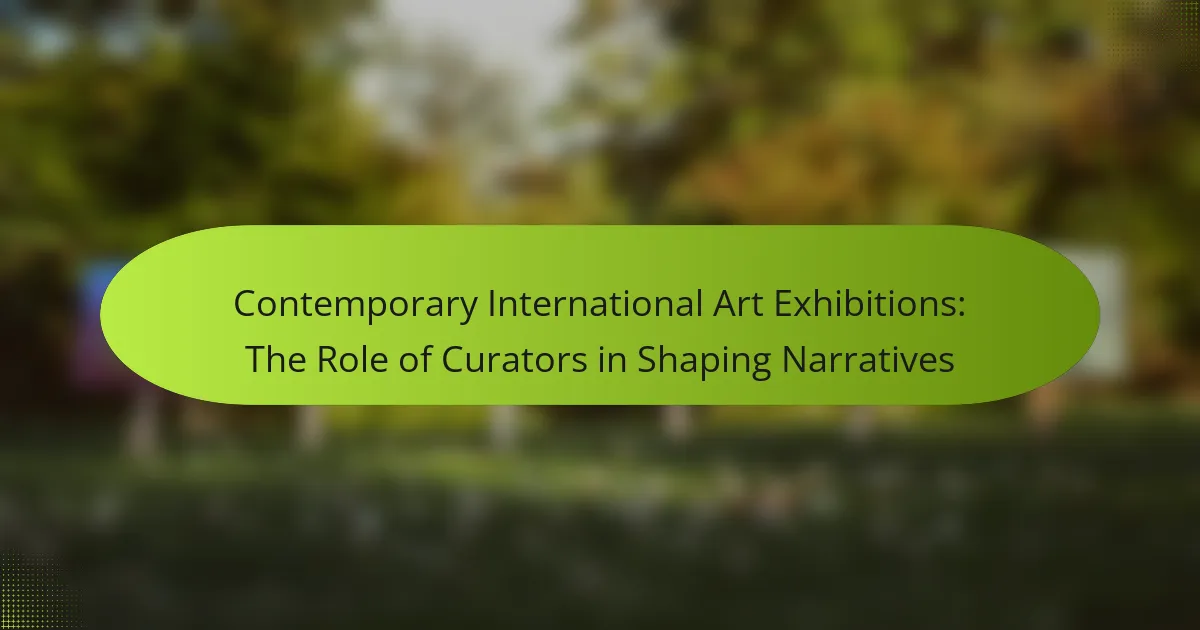Contemporary international art exhibitions influence cultural identity by fostering dialogue and cultural exchange. They showcase diverse artistic expressions, enhance visibility for underrepresented voices, and challenge societal norms. These exhibitions also address themes like globalization, migration, and sustainability, promoting empathy and understanding among audiences. Understanding demographic influences on engagement helps create inclusive experiences that resonate across cultures.
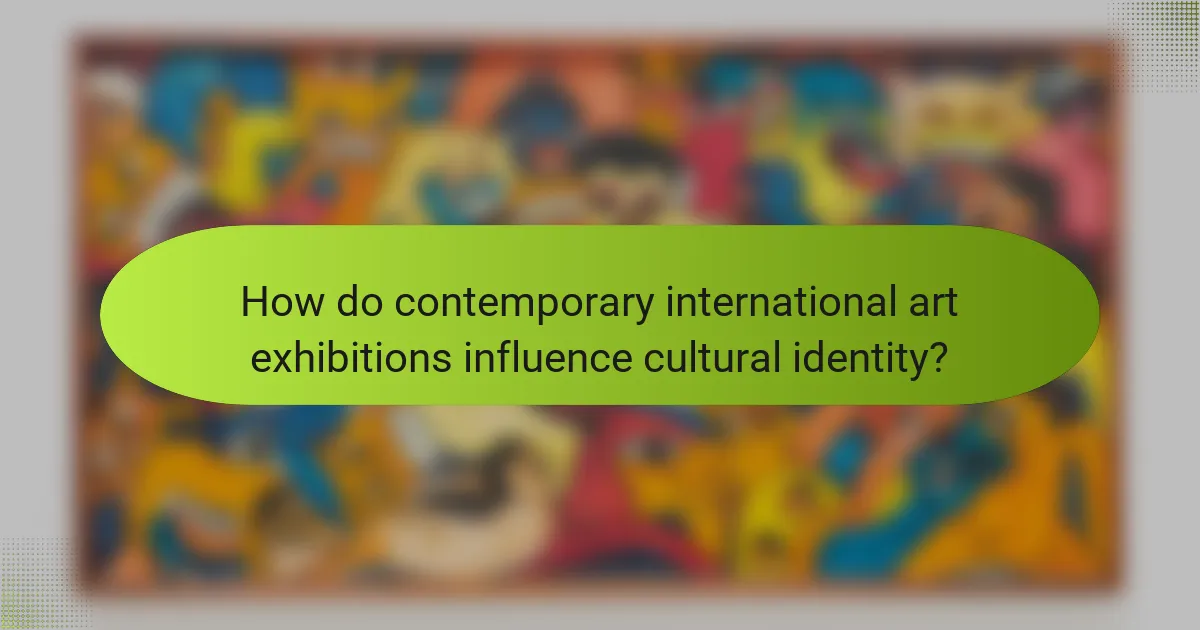
How do contemporary international art exhibitions influence cultural identity?
Contemporary international art exhibitions significantly shape cultural identity by fostering dialogue and cultural exchange. These exhibitions showcase diverse artistic expressions, encouraging viewers to engage with different cultural narratives.
They provide a platform for artists from various backgrounds, enhancing visibility for underrepresented voices. This exposure cultivates a deeper understanding of global perspectives, promoting empathy and appreciation for cultural diversity.
Moreover, contemporary art often challenges societal norms and provokes critical conversations about identity, heritage, and globalization. As a result, these exhibitions not only reflect cultural dynamics but also actively participate in redefining them.
In summary, contemporary international art exhibitions play a crucial role in influencing cultural identity through dialogue, representation, and the challenging of existing narratives.
What role do these exhibitions play in shaping national narratives?
Contemporary international art exhibitions play a crucial role in shaping national narratives by fostering cultural dialogue and identity. These exhibitions often reflect and challenge societal values, offering diverse perspectives that resonate with local and global audiences. They create platforms for artists to express their cultural heritage, promoting understanding and empathy among different communities. By showcasing unique artistic expressions, these exhibitions can influence public discourse and national identity, highlighting the interplay between art and society. Additionally, they often contribute to tourism and local economies, further embedding cultural narratives within the national context.
How do local artists benefit from international exposure?
Local artists gain visibility, networking opportunities, and cultural exchange from international exposure. Contemporary international art exhibitions allow artists to showcase their work on a global stage. This exposure enhances their cultural identity and fosters dialogue with diverse audiences. As a result, artists can attract collaborations, gain recognition, and influence their local art scenes positively.
In what ways do exhibitions foster cross-cultural dialogue?
Exhibitions foster cross-cultural dialogue by showcasing diverse artistic expressions and encouraging interaction. They create platforms for artists from various backgrounds to share their narratives, promoting understanding and respect. These events often include workshops, discussions, and collaborative projects that deepen cultural exchanges. As a result, attendees gain insights into different perspectives, enhancing global awareness and empathy.
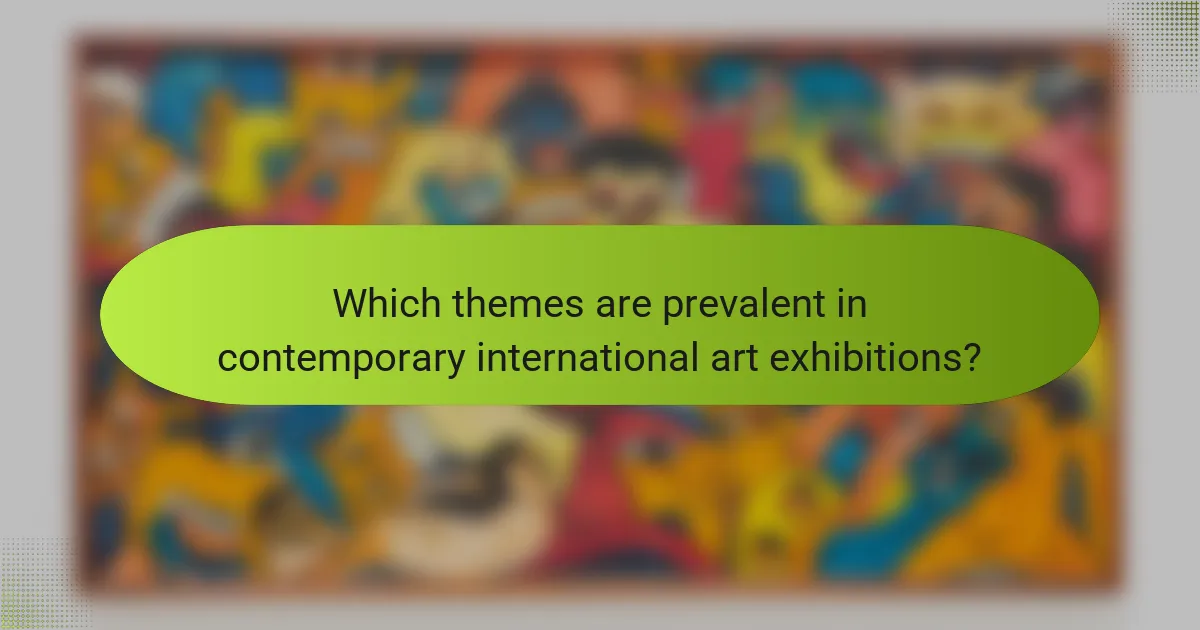
Which themes are prevalent in contemporary international art exhibitions?
Contemporary international art exhibitions often focus on themes of cultural identity, globalization, and social justice. These themes foster dialogue among diverse audiences and reflect current societal issues. For instance, exhibitions frequently explore the impact of migration on cultural narratives, highlighting personal stories that resonate universally. Additionally, many exhibitions emphasize environmental concerns, showcasing art that raises awareness about climate change and sustainability. The integration of technology in art also serves as a prevalent theme, allowing for innovative expressions and interactions that challenge traditional boundaries.
How do political issues manifest in exhibition themes?
Political issues manifest in exhibition themes through the exploration of identity, social justice, and global conflicts. Contemporary international art exhibitions often reflect societal tensions and cultural narratives. For example, themes may address migration, inequality, or environmental concerns, fostering dialogue among diverse audiences. These exhibitions serve as platforms for artists to critique political landscapes, highlighting the intersection of art and activism. By engaging with these themes, exhibitions contribute to a broader understanding of cultural identity in a globalized context.
What cultural narratives are often highlighted through art?
Contemporary international art exhibitions often highlight cultural narratives related to identity, history, and social issues. These exhibitions serve as platforms for dialogue, showcasing diverse perspectives and fostering understanding among different cultures. Artworks often reflect themes of migration, globalization, and community, emphasizing shared human experiences. By engaging audiences, these exhibitions help shape cultural identity and encourage critical conversations about societal challenges.

What are the economic impacts of contemporary international art exhibitions?
Contemporary international art exhibitions significantly boost local economies through tourism, job creation, and cultural investment. These events attract visitors, enhancing local businesses and fostering international dialogue. For instance, large exhibitions can increase hotel occupancy rates by over 30%. Additionally, they promote cultural identity, showcasing diverse artistic expressions that resonate globally. The unique aspect of these exhibitions is their ability to bridge cultural gaps, fostering understanding and collaboration among nations.
How do these exhibitions contribute to local economies?
Contemporary international art exhibitions significantly contribute to local economies by attracting tourism and fostering community engagement. These events generate revenue through ticket sales, hospitality, and retail. For example, a major exhibition can increase hotel occupancy rates and boost local restaurants and shops. Additionally, they create jobs in the arts and service sectors, enhancing the economic landscape. The cultural dialogue fostered by these exhibitions enriches the community, promoting cultural identity and appreciation.
What is the role of sponsorship and funding in shaping exhibitions?
Sponsorship and funding significantly influence contemporary international art exhibitions by providing essential resources and shaping thematic direction. Financial support allows for the inclusion of diverse artists and innovative works, enhancing cultural dialogue. Additionally, sponsors often seek alignment with specific cultural narratives, which can impact the exhibition’s focus. This relationship between funding and artistic expression reflects the unique attributes of contemporary art, where financial backing can either promote inclusivity or create barriers based on commercial interests. As a result, the dynamics of sponsorship play a crucial role in defining the cultural identity represented in these exhibitions.
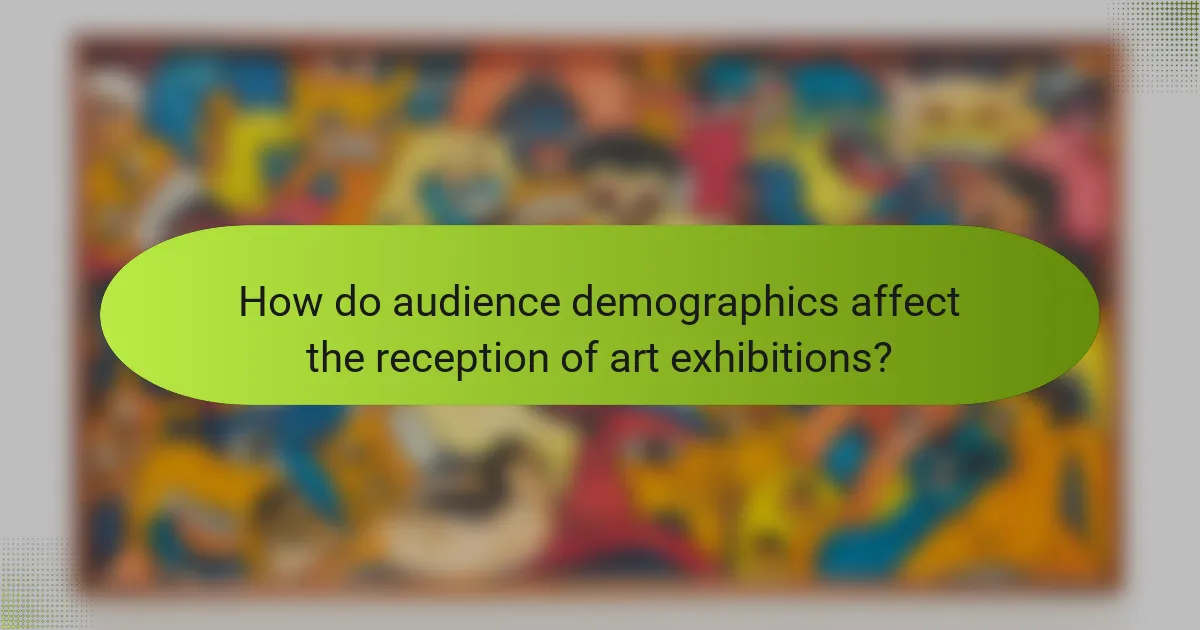
How do audience demographics affect the reception of art exhibitions?
Audience demographics significantly influence how art exhibitions are received. Different age groups, cultural backgrounds, and socioeconomic statuses shape individual interpretations and emotional responses to contemporary art.
For instance, younger audiences may prioritize innovative techniques and social commentary, while older demographics might focus on historical context and traditional forms. Cultural identity plays a crucial role, as individuals from diverse backgrounds bring unique perspectives, enriching dialogue around the artwork.
Moreover, socioeconomic factors can affect access to exhibitions, impacting overall engagement. Communities with limited resources may not experience the same exposure to contemporary art, leading to varied appreciation levels.
Ultimately, understanding these demographic influences helps curators design exhibitions that resonate with broader audiences, fostering inclusivity and dialogue.
Which audience segments are most engaged with contemporary art?
Young adults and art enthusiasts are the most engaged audience segments with contemporary art. These groups actively participate in exhibitions, fostering cultural dialogue. Additionally, collectors and academics show significant interest, contributing to discussions around cultural identity. Social media users also amplify engagement, sharing experiences and perspectives on contemporary art.
How do cultural backgrounds influence audience interpretations?
Cultural backgrounds significantly shape audience interpretations of contemporary international art exhibitions. These influences manifest through personal experiences, societal norms, and historical contexts that inform how art is perceived.
For instance, an artwork reflecting a specific cultural identity may resonate differently with audiences from diverse backgrounds. Visitors from similar cultural contexts might connect deeply with the themes presented, while others may interpret the same piece through their unique lenses.
Moreover, art exhibitions often serve as platforms for dialogue, allowing for the exchange of cultural narratives. This interaction fosters a deeper understanding of varying perspectives and encourages discussions about identity and representation in art.
Ultimately, the impact of cultural backgrounds on audience interpretations underscores the importance of inclusivity in contemporary art, enhancing the dialogue around cultural identity.
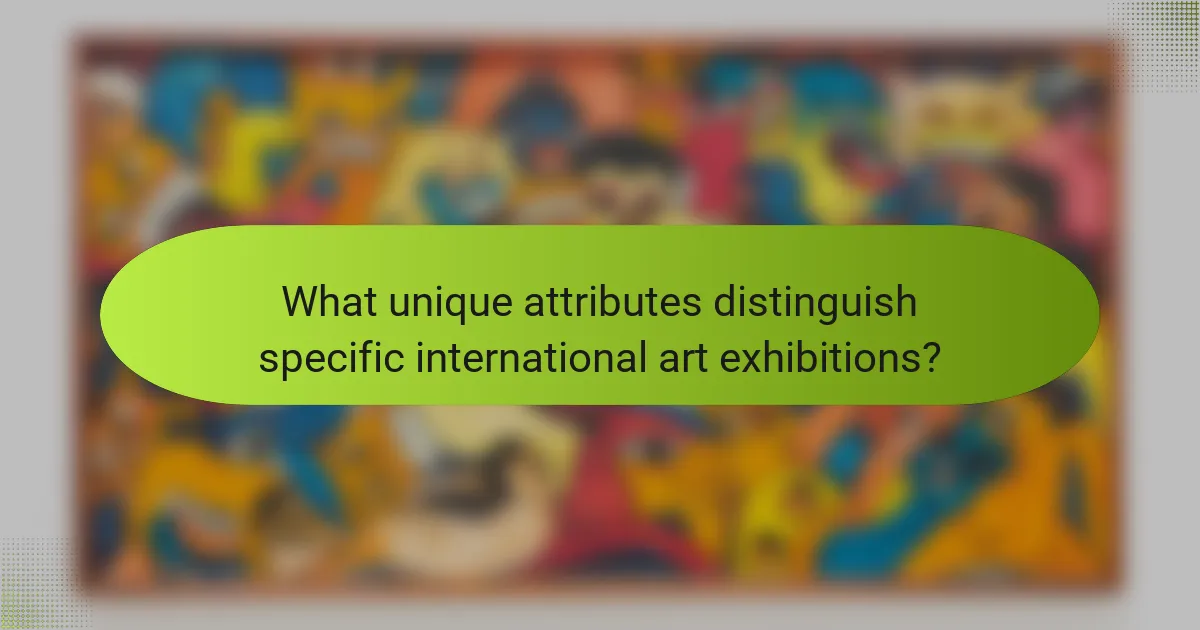
What unique attributes distinguish specific international art exhibitions?
Unique attributes that distinguish specific international art exhibitions include their thematic focus, cultural representation, and audience engagement strategies. These exhibitions often showcase diverse artistic expressions, fostering dialogue among different cultures. For instance, some exhibitions emphasize social issues, while others highlight regional art forms. The unique context of each exhibition can significantly influence cultural identity and perceptions of contemporary art. Additionally, the inclusion of interactive elements or technology can enhance viewer experiences, making each event distinct.
Which exhibitions have garnered global attention and why?
Contemporary international art exhibitions have garnered global attention due to their ability to foster cultural dialogue and identity. Events like the Venice Biennale and Art Basel showcase diverse perspectives, attracting artists and audiences worldwide. These exhibitions often challenge societal norms, provoke thought, and encourage collaboration across cultures. For instance, the Venice Biennale’s unique attribute lies in its long-standing tradition and international representation, making it a benchmark for contemporary art. As a result, these exhibitions not only elevate artistic expression but also serve as platforms for addressing pressing global issues.
How do regional differences shape the presentation of art?
Regional differences significantly influence the presentation of art in contemporary international exhibitions. These variations reflect cultural identities, artistic traditions, and societal values.
Exhibitions often showcase local artists, addressing themes relevant to their communities. For instance, a European exhibition may emphasize historical narratives, while an Asian exhibition might focus on modern interpretations of traditional practices.
Additionally, the choice of medium and style can differ based on regional preferences. Some regions may favor installation art, while others may highlight digital or performance art.
As a result, these exhibitions foster cross-cultural dialogue, allowing diverse perspectives to be shared and appreciated globally.
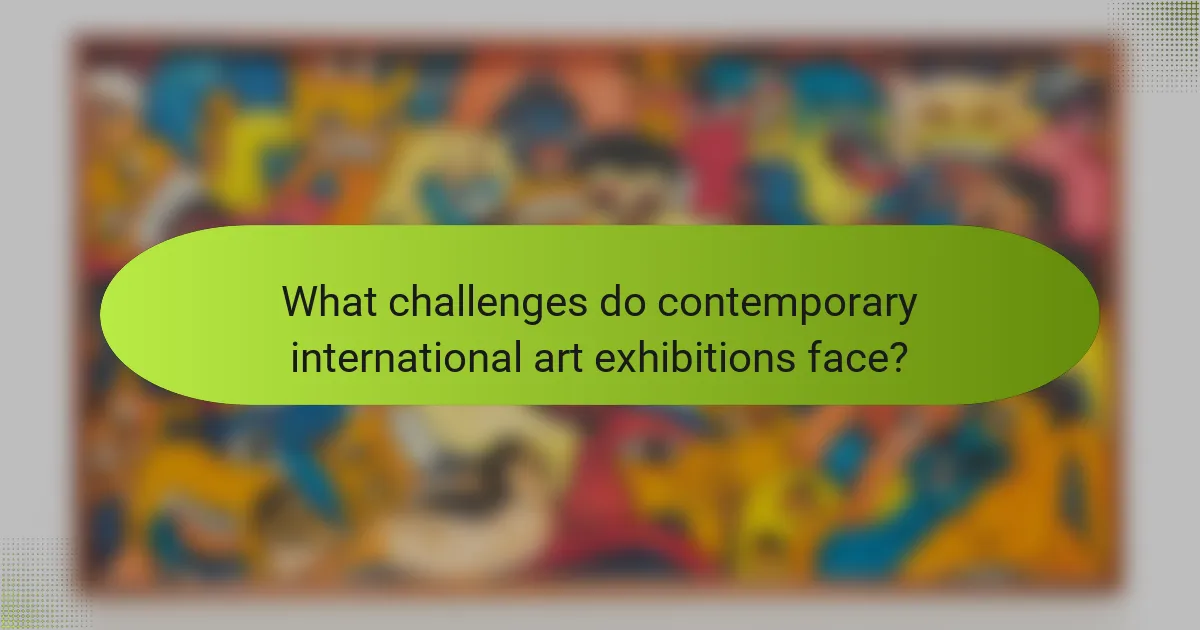
What challenges do contemporary international art exhibitions face?
Contemporary international art exhibitions face challenges such as cultural representation, audience engagement, and funding issues. These exhibitions often struggle with ensuring diverse voices are included, which can impact cultural identity. Additionally, attracting and engaging audiences in a digital age requires innovative approaches. Funding remains a critical issue, as many exhibitions depend on sponsorship and grants, which can be unpredictable. As a result, these challenges can hinder the dialogue that art aims to foster across cultures.
How do political climates impact the organization of exhibitions?
Political climates significantly influence the organization of contemporary international art exhibitions. Shifts in governance can dictate funding, themes, and the selection of artists. For instance, authoritarian regimes may restrict artistic expression, leading to censored or politically aligned exhibitions. Conversely, democratic environments often encourage diverse voices, fostering dialogue and cultural exchange. The unique attribute of a political climate can shape the narrative and accessibility of art, impacting cultural identity. Exhibitions can become platforms for resistance or celebration, reflecting the socio-political landscape.
What logistical issues are common in international exhibitions?
Common logistical issues in international exhibitions include transportation delays, customs clearance challenges, venue accessibility, and coordination among diverse stakeholders. These factors can significantly impact the presentation and reception of contemporary art, influencing cultural identity and dialogue. Effective planning and communication are essential to mitigate these challenges.
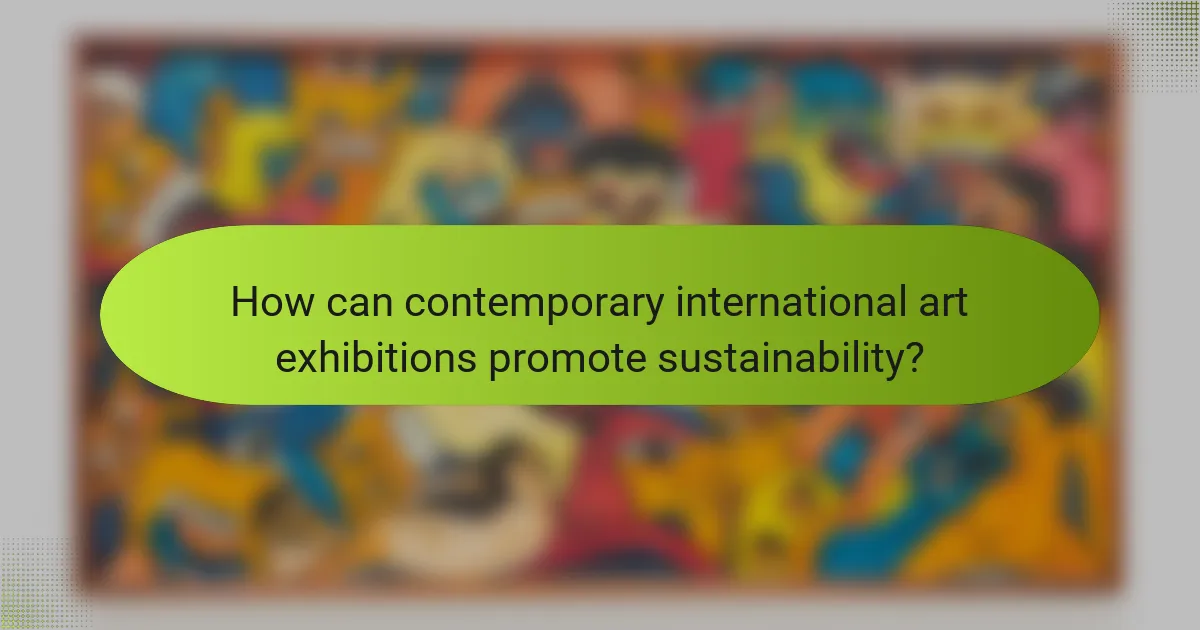
How can contemporary international art exhibitions promote sustainability?
Contemporary international art exhibitions can effectively promote sustainability by showcasing eco-conscious practices and fostering dialogues on environmental issues. These exhibitions often highlight artists who use sustainable materials, encouraging audiences to consider their ecological impact.
Furthermore, many exhibitions integrate educational programs that raise awareness about sustainability, making art a vehicle for social change. Collaborations with environmental organizations amplify this message, creating a broader cultural dialogue around sustainability.
As a result, contemporary art becomes a platform for discussing cultural identity and environmental responsibility, bridging gaps between communities through shared values and concerns.
What practices are being adopted to reduce environmental impact?
Contemporary international art exhibitions adopt various practices to reduce environmental impact. These include using sustainable materials, minimizing waste, and promoting digital engagement to lower carbon footprints.
Exhibitors increasingly prioritize eco-friendly installations, often opting for recycled or locally sourced materials. Many events implement waste management strategies, focusing on recycling and composting. Additionally, digital platforms enhance accessibility while reducing the need for physical travel, contributing to lower emissions.
Art institutions are also collaborating with environmental organizations, integrating sustainability into their programming. This approach fosters a dialogue around cultural identity and environmental responsibility, encouraging audiences to reflect on their roles in a changing world.
Overall, these practices signify a commitment to reducing environmental impact while enriching cultural dialogue within contemporary art.
How do exhibitions raise awareness about global sustainability issues?
Exhibitions raise awareness about global sustainability issues by showcasing diverse artistic perspectives that provoke dialogue. They highlight environmental challenges and inspire action through immersive experiences. Artists often incorporate sustainable practices, emphasizing the importance of ecological consciousness. This engagement fosters a cultural identity rooted in sustainability, encouraging community involvement and global collaboration.
What best practices can enhance the impact of art exhibitions?
To enhance the impact of contemporary international art exhibitions, focus on community engagement and interactive elements. Utilizing local artists can foster deeper connections with cultural identity. Incorporating diverse media, such as digital installations, can attract broader audiences. Collaborative workshops during exhibitions encourage dialogue and participation. Evaluating visitor feedback helps refine future exhibitions for greater relevance and impact.
How can curators effectively engage diverse audiences?
Curators can effectively engage diverse audiences by creating inclusive and accessible art experiences. They should prioritize community involvement and utilize interactive elements to foster dialogue.
Incorporating multilingual resources enhances accessibility, allowing broader participation. Curators can host workshops and discussions that reflect various cultural perspectives, promoting a sense of belonging.
Utilizing social media platforms expands reach and encourages audience interaction. Curators can share behind-the-scenes content and artist interviews to deepen connections.
Finally, evaluating audience feedback is essential. This data helps curators adapt future exhibitions to better meet the needs of diverse communities.
